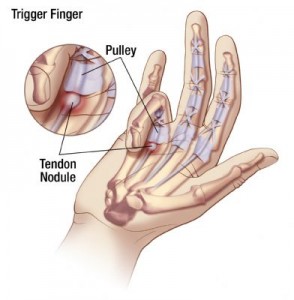Cubital Tunnel Syndrome is a condition where the ulnar nerve of the upper extremity is pinched as it passes behind the elbow. Nerve compression from increased pressure leads to numbness, tingling, pain, and weakness of the affected arm and hand.
Cubital tunnel syndrome often presents as a tingling sensation in your hand like you have hit your “funny bone.” When you do hit your elbow a certain way, the sensation you feel is the result of irritation to the ulnar nerve. This leads to a shooting sensation of tingling, pain, and numbness into the small finger and the ring finger. Your ulnar nerve will transmit a signal to your brain to allow these sensations to be felt.
What causes Cubital Tunnel Syndrome?
Cubital Tunnel Syndrome is the result of some form of pressure on the ulnar nerve. Pressure on the ulnar nerve develops in several different ways. The ulnar nerve is located right next to the bone and doesn’t have much padding over it. When pressure is put on this nerve, the syndrome develops.
Pressure on the ulnar nerve can also occur when you keep your elbow bent in a certain position for a long time. This stretches the nerve as it crosses through the cubital tunnel and narrows the tunnel itself. This often occurs during sleep. It may also occur when holding a phone for a prolonged period of time.
For some people, the connective tissue over the nerve gets thicker and this causes pressure on the nerve. Cubital Tunnel Syndrome occurs when the pressure is significant enough and sustained enough to interfere with the way this particular nerve functions.
What are the symptoms of Cubital Tunnel Syndrome?
If you have this syndrome, you will have pain, numbness, and tingling in the small finger and the ring finger. These symptoms are generally felt when you have pressure on the nerve such as sitting with the elbow on an arm rest or during a repetitive motion of moving the elbow in a bending position and then straightening it.
In addition, you will have weakness of the muscles in the hand or clumsiness with use of the hand. These weakened muscles are called the intrinsic muscles of the hand, and they help with finger movements. People who have more severe symptoms will frequently drop objects that they pick up and also have difficult with the fine motor movements of the fingers.
How is Cubital Tunnel Syndrome diagnosed?
The diagnosis of Cubital Tunnel Syndrome is concluded after a complete history and examination is done by an orthopedic specialist. If there is a concern that something abnormal may be causing the nerve compression, X-Rays and other imaging may be necessary to evaluate this elbow, arm and hand. Nerve conduction studies, called EMGs, will help the doctor determine the extent and location of the nerve compression.
How is Cubital Tunnel Syndrome treated?
Many people can be treated for Cubital Tunnel Syndrome with anti-inflammatory medications, especially if the EMG test shows that the pressure is only minimal. Sometimes, the orthopedic specialist will splint the elbow, especially at night. Another treatment option is the use of padding for the elbow during work or sporting activities. If these non-operative treatments fail to provide relief, surgery will be necessary to eliminate the pressure from the ulnar nerve.
Surgery for Cubital Tunnel Syndrome
The goal of surgical treatment for Cubital Tunnel Syndrome is to alleviate the pressures on the Ulnar Nerve. This can be accomplished through a minimally invasive technique called Endocscopic Cubital Tunnel Release. Dr. Weil is currently the only surgeon at Swedish Hospital performing this type of surgery. It involves a small incision behind the elbow in order to insert the camera into the tunnel and to release the nerve.
Post-operatively, patients are placed in a soft bandage for 4 days and can resume light activities immediately after surgery. The recovery from this type of surgery is much faster than traditional open surgical approaches.
Patients who are not candidates for this procedure can be treated with open procedures such as an ulnar nerve transpostion. This involves moving the ulnar nerve from the back of the elbow to the front of the elbow. The nerve may be put under a layer of fat, under the muscle tissue, or deep within the muscle. Following surgery, recovery depends on what the surgery entailed and what needed to be done. Most people recover well in a couple of months.


 Trigger finger is a common condition that results in pain and snapping of the tendons at the base of the finger or thumb. These tendons are like pulleys that attach to the ends of the fingers to allow for finger movement. As the forearm muscle contracts, the tendons pull each finger into a fist. With trigger finger, this mechanism is not smooth and a snapping sensation can be felt, causing pain.
Trigger finger is a common condition that results in pain and snapping of the tendons at the base of the finger or thumb. These tendons are like pulleys that attach to the ends of the fingers to allow for finger movement. As the forearm muscle contracts, the tendons pull each finger into a fist. With trigger finger, this mechanism is not smooth and a snapping sensation can be felt, causing pain.